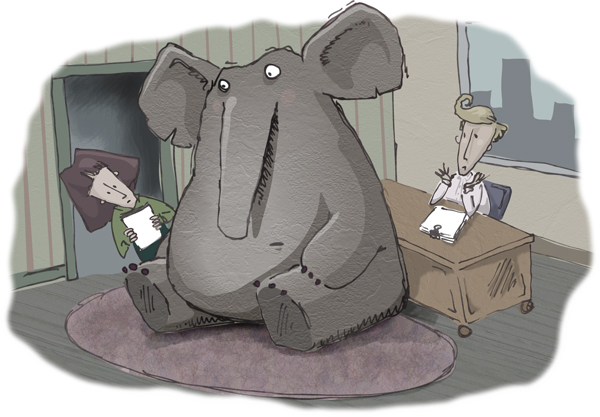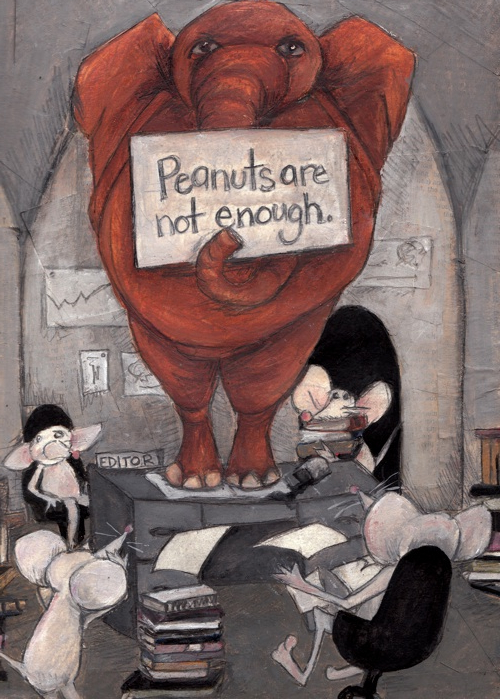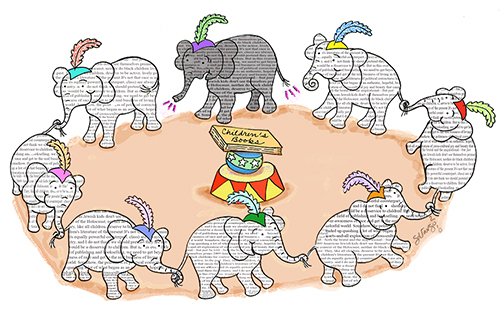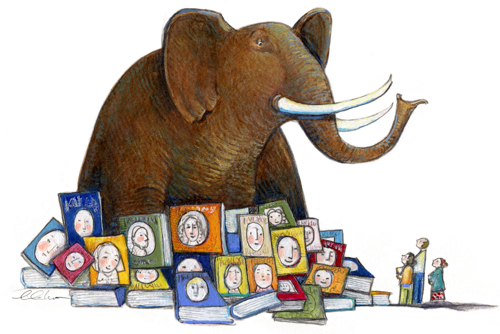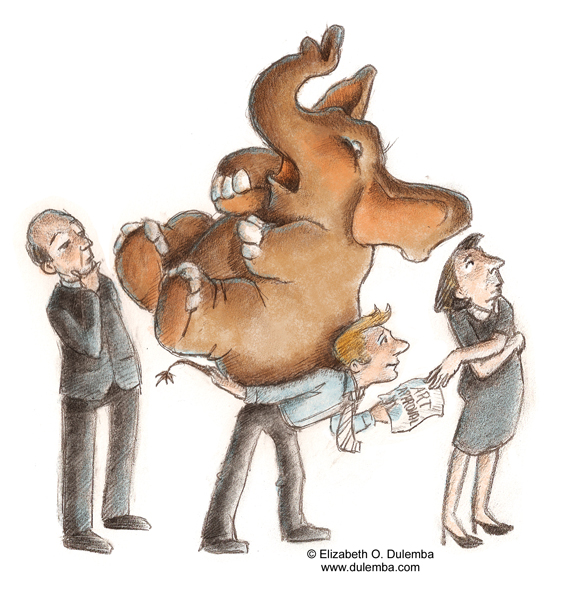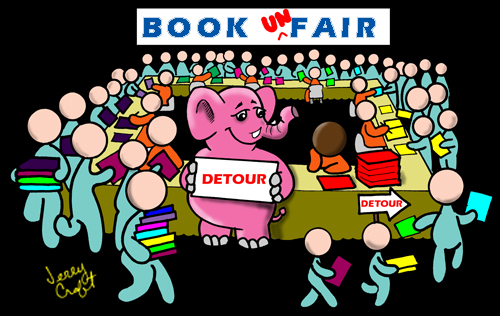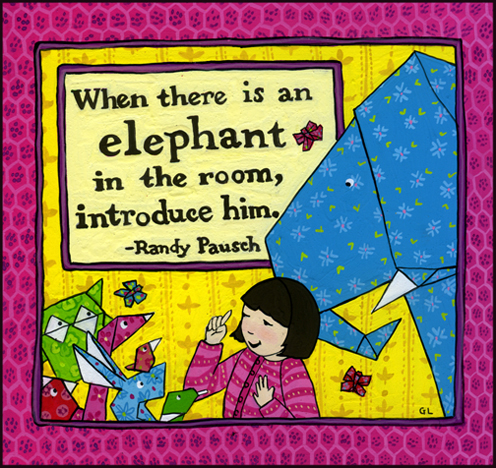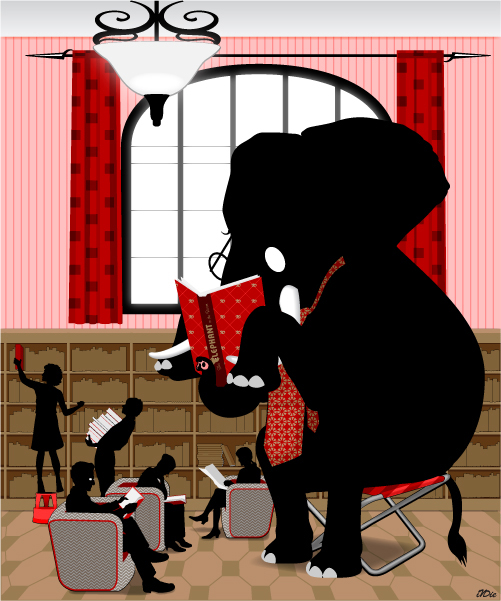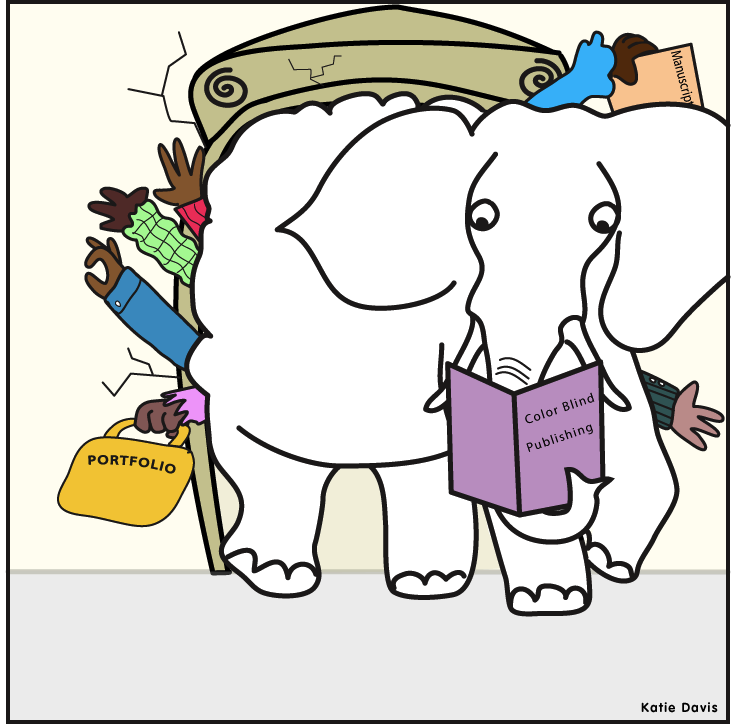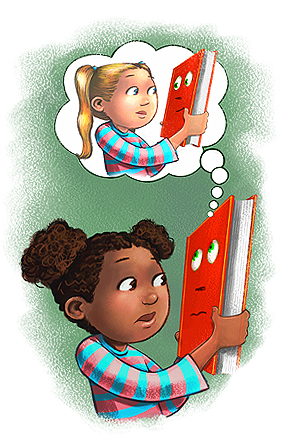Publishers, how ivory are thy towers? According to statistics—not to mention a quick glance around any trade show floor—pretty shockingly ivory, maybe along the lines of 98%. The number of publishing, editorial, art direction, sales and marketing professionals of color in our field is tiny, and that’s not good for anybody. This discrepancy between the real world and the publishing world limits the range of books published, the intellectual scope of discussion, and—for the bottom-liners—greatly stunts the potential market.
The truth: we in the book trade have fallen shamefully behind our own culture, and our own times. We can remedy that with open dialogue, new paradigms, and concerted effort. And—we have to remedy it. When adults shout racial epithets at our country’s elected leaders, when bullied children are hanging themselves out of despair and shame, when children’s faces in art murals on the sides of schools are criticized for being “too dark,” when racism is still alive and vicious in this country, we can’t politely avert our eyes.
It is our responsibility—as people who create, produce, and distribute the lion’s share of books that reach and teach and entertain children—it is our highest calling to provide written, illustrated worlds that embrace and prioritize all children, books that resemble the playgrounds and classrooms and homes of this country and the rest of the world. And in order to do that, we must open the gates of our publishing houses to a greater variety of voices and cast aside outdated assumptions of what people will or won’t want to read, will or won’t want to edit or publish or sell.
So how do we do it?
The good news is that there is a growing movement afoot among children’s book people—mainly authors and artists, but also editors and agents and booksellers and librarians—to address these imbalances and make real change happen. Social networking and blogs and the Internet have made it possible for like-minded people to find one another, and for people to respond quickly and vocally to unacceptable practices, like book-cover whitewashing. Having our first African-American president has also brought race into the public dialogue more openly than it has been since the 1970s.
The population of the United States is becoming more and more diverse, rapidly. Every indicator points to now as THE TIME for racial progress and equality to make its next big advance. It’s time to face up to things, the time to move forward, the time to form new models for business and commerce.
I’ve titled this blog post “The Elephant in the Room,” because discussions of race among mostly Caucasian, primarily liberal, adults are so often fraught with perceived landmines and sincere attempts not to be or seem racist that real dialogue seldom gets beyond square one.
However, just as a recent study about children’s attitudes toward race indicated that adults’ avoidance of the topic (however well-meaning) led to increased racial stereotyping and negative perceptions on the part of the children, so does our avoidance of the issue in our own field do harm rather than good.
Illustrator Anne Sibley O’Brien is currently running a three-part series on race in the Society of Writers and Illustrators (SCBWI) Bulletin. In the May/June 2010 issue article, “White Mind (Part 1),” O’Brien notes: “Being a dominant group member is like having a free pass that members of outgroups don’t have, but with no awareness of having it.” She cites a Harvard brain research study showing “the presence of implicit bias as a universal human experience. When we think about people like ourselves, [the scientists] report, a certain part of our brains light up; when we think about people different from us, a different part lights up.
This kind of bias is completely unconscious, Banaji states, present in people who are absolutely positive they don’t have it and who are committed to treating everyone fairly (and think they do). According to Banaji’s studies, 80% of whites show bias for the white race; people of non- majority races do not show this bias for their race. These implicit biases can drive our behaviors without our awareness.” She continues, “From writing and illustrating to hiring publishing staff, editing and marketing to selling, buying and reviewing, White Mind affects children’s books today. Unless we become aware of and develop strategies to directly challenge these patterns, white norms will continue to prevail.”
Professor and author Zetta Elliott‘s article, “Something Like an Open Letter to the Children’s Publishing Industry,” articulates the frustrating refusal of industry leaders to address this issue. “Their silence has been deafening. What can they say? That they collectively lack the daring, the moral clarity, the fiscal incentive to do right by our kids? Perhaps they will say, ‘The market can’t sustain more books by and about people of color. There simply isn’t enough demand.’ And so they will continue to promote their endless books about Harriet Tubman and Dr. Martin Luther King, Jr., knowing that educators and librarians across the country need *something* to display when Black History Month rolls around…”
Citing studies showing that Black and Hispanic kids suffer disproportionately from homophobic bullying, with higher rates of suicide and suicide attempts, she concludes: “What I am trying to say to children’s publishers is that the lack of books for children in our communities IS A MATTER OF LIFE AND DEATH. I am not asking you to level the playing field as a “favor” to people of color. I am asking you to work with us in our efforts to transform children’s lives. Isn’t that why you chose this field in the first place?” Amen.
She continues, “And, of course, there is a desperate need for ‘slice of life’ stories that don’t (only) focus on racial or cultural conflict; I’m partial to wild geese and willow trees, but those aren’t the books editors and agents seem to champion. People of color make up a third of the population, and before too long, we’ll reach 50%. In 2050 will we still be petitioning the children’s publishing industry to be more responsive to our needs – OUR urgencies?”
It’s pretty clear where we are and where we need to go. What I’d like to do is open the conversation by offering some positive, creative steps we can all take to make the world of children’s books—behind the scenes, in addition to between the covers—catch up to the amazing, diverse, infinitely rich world those books are meant to reflect and celebrate.
You’ll notice marvelous art throughout this post. When I started thinking about what I wanted to say about racial representation not just in books, but in the halls of publishing houses, I knew I didn’t want mine to be the only voice, and I knew I wanted to use art. Sending out an appeal to artist friends and colleagues brought 13 interpretations of the “elephant in the room” theme. Our grateful thanks and admiration to artists Kevan Atteberry, Addie Boswell, Jerry Craft, Katie Davis, Nancy Devard, Elizabeth O. Dulemba, Laura Freeman, Erin Eitter Kono, Grace Lin, Nicole Tadgell, and Sharon Vargo for devoting their time and energy and care on these pieces, which they have contributed to this post freely. Clicking on their artwork will take you to their websites; please visit and explore their other fine work. A special thanks to author/publisher Cheryl Hudson (Just Us Books), who not only helped me connect with several artists, but whose ongoing effort to support and uplift authors and artists of color and readers of all races is a true inspiration.
WHAT PUBLISHERS CAN DO:
Explore the DIPNET Publishing Equalities Charter.
Assess your company with clear, honest eyes and minds. Contact the AAP’s Diversity Recruit & Retain Committee for assistance with hiring, recruitment, and mentoring efforts. Consider creating an in-house group to address equality policies and practices in your house.
Believe that this issue affects the future of publishing every bit as much as emerging technologies. As someone said, the world is a salad, not a melting pot, and becomes ever more so. Want to sell more books? Market books to the real world, as it is now, and as it’s becoming.
A truly diverse, exciting publishing program cannot be achieved with a 98% Caucasian workforce. Check out www.bookjobs.com when hiring.
Be broad-minded in your view of diversity. It’s not just a black/white issue, but includes all races, colors, creeds, and religious beliefs, as well as age, gender, sexual orientation, and class.
From the UK Publishing Equalities Charter: “Provide specific training/development to staff from under-represented groups to enhance career progression into middle/senior management.”
In her article, “Demanding Diversity in Publishing,” Zetta Elliott quotes the above and adds, “Recognizing that ‘publishers, trade associations, booksellers and other organisations related to the publishing industry’ vary in size, the charter suggests that each ‘champion’ two to four actions per year, and welcomes ‘any other suggestions that promote equal opportunities.’ Most importantly, signatories to the charter agree to complete an annual survey, which will enable progress to be MONITORED.”
Re-evaluate WHY books with brown faces on the cover sometimes, even often, sell less well than books with white faces. As a bookseller who has worked in both extremely diverse and extremely homogenous environments, I am convinced that this is a result of misdirected marketing. A more diverse talent pool will help you get the message out about your books in ways that reach more people.
What do you want to accomplish with your role as publisher?
Olugbemisola Rhuday-Perkovich, blogger and author of 8th Grade Superzero, notes: “…the industry is failing *everyone*, not just under-represented groups, when it continues to promote and present a largely homogenous, narrow perspective. I hope that children’s publishing in particular will recognize the opportunity here to play a role in creating a more just society in which every voice has value… Looking at the current state of things, a reader doesn’t even have to be particularly thoughtful to see that this just doesn’t make sense. (Or cents, even. It’s hard for me to believe that a more inclusive industry would not be able to reap tangible rewards.)… By each of us taking responsibility to do *something* that will increase diversity in publishing, we can demonstrate a real understanding and effect real change.”
WHAT EDITORS CAN DO:
Give books by or about people of color more than one or two “slots” per season. That leads to the inevitable predictable deluge of books about slavery and Civil Rights. These are important books, of course. But imagine if we only published books about pilgrims for white children, and you’ll quickly see that this approach is absurd. Children are HUNGRY to see themselves in books about regular kids doing everyday things. Or as fantasy heroes. Where is the black Twilight? Or the Asian Harry Potter?
Don’t assume authors and artists and editors of color only want to write and illustrate and edit books about characters of color.
In committee, describe books by authors and illustrators of color, and/or about characters of color, the same way you would books about and/or by white people. That is, use active language that compels the reader. Talk about the story, not the race of the characters.
Revisit your assumptions and biases. We all have them, and have to work to set them aside. For example, if you believe a book with a brown face on the cover isn’t “for” you or your family or friends, you will have a hard time supporting that book in a way that it will reach a broad audience.
Avoid stereotypes not only of people, but of settings and assumed experiences. Not all nonwhite kids live in urban environments, obviously, and even when they do, there’s a rich diversity of experiences and voices within those settings that aren’t yet reflected in books.
Recruit, mentor and support editorial assistants of color. Consider visiting classrooms to introduce children and teenagers to the world of publishing and the variety of jobs available.
Work harder to communicate honestly and openly with authors of color when you have questions about their work. Politeness often makes us shirk conversations that would be fruitful.
WHAT SALES & MARKETING CAN DO:
Never, ever advocate whitewashing a book cover. The moral cynicism of this action is a terrible betrayal of your authors and readers. It bankrupts your reputation and is not easily forgotten. In this age of instant social networking, it will be discovered and shared.
Resist the habit of speaking about a book featuring a character of color as a book only FOR people of color. If Shabanu, a Newbery Medal winner, had been written by an author of color, would it have been pitched differently? And possibly missed its deservedly broad, cross-cultural audience, not to mention its award?
Challenge buyers to broaden their vistas. This is tricky, because you don’t want to seem to be questioning a bookseller’s understanding of her/his market, but if you can convey your own enthusiasm for a book rather than introducing it with apology or phrases like, “This might not sell in your store, but…” you can model for booksellers better ways to talk with their customers about the books. Focus on the story, the heart, the humor. That’s universal.
See PUBLISHER notes for thoughts on marketing books with a colorful cast of characters.
WHAT ART DIRECTORS CAN DO:
(See “no cover whitewashing” above.)
Ask yourselves, does the family in this picture book have to be white? White is not the default race, and every week—if not more often— I have customers both white and of color asking me for books with diverse families. And this is in VERMONT.
Watch out for the “white kid in front” habit. It drives me nuts to see a multicultural cast of characters all grouped deliberately behind the white kid, who’s the central active figure on the cover. White people WILL buy books with diverse casts of characters; please give all readers more credit.
WHAT BOOKSELLERS AND LIBRARIANS CAN DO:
Books are books. The good ones cross universal lines; they aren’t black-interest books, white-interest books, Chinese-interest books. They are books. Believe in your own passion for stories and literature and nonfiction, and hand the best books to kids of all colors, about people of all colors.
Encourage customers to step outside their comfort zone, especially by focusing on the story, not the race of the protagonists. “This kid is given a quadrillion-dollar bill and Secret Agents are trying to get it back.” “Bobby used to have a girl best friend, but now they’re in fourth grade, and things are changing. Everything starts going wrong; he can’t even hug a tree without getting stuck to it.” “Alvin, descended from warrior farmers, is afraid of everything. Now he’s in a public school and exposed to a neighborhood full of potential disasters.” Hook ’em with the good stuff; they won’t care two hoots about race.
Become familiar with a wider array of books, especially from small presses specializing in multicultural books.
Let your customers know that you carry a strong selection of multicultural books. Even in homogenous (white) neighborhoods, you’ll often be surprised by how many people appreciate and buy the books you’ve made available to them.
Let your sales reps know you’re interested in broadening your selection. This is a fruitful conversation.
***
This is just the tip of the iceberg, even though this post is long. Please join in the conversation about what we can do better, where we can join forces, and how to make change that lasts. Anyone interested in joining a group of book people talking this issue, please email me, Elizabeth, at Shelftalker2@gmail.com for an invitation to an online discussion group.
****
LINKS OF INTEREST (special thanks to Christine Taylor-Butler for sharing several of these links, not to mention many, many conversations about this issue) [Note: updated June 13, 2010]:
A World Full of Color, the tagged, sortable library I put together of 500+ titles in print featuring kids of color where race is not the driving force of the story. Publishers, please continue to send me new titles to add to the catalog.
Zetta Elliott’s “Demanding Diversity in Publishing” and Something Like an Open Letter to the Children’s Publishing Industry.
Association of American Publishers (AAP) Diversity Recruit & Retain Committee. “AAP’s Diversity/Recruit & Retain Committee works to attract talented, diverse voices to the book publishing industry with its “Book Yourself a Career” campaign. The centerpiece of the campaign is the Bookjobs.com website, which serves as a comprehensive database of internships and jobs at all levels in the industry and serves as a “one-stop-shopping” resource for information about book publishing. The campaign includes a college outreach initiative which publicizes the website on college campuses, focusing especially on schools with high academic standards and a diverse student population.”
DIPNET “The Diversity in Publishing Network has been established to promote the status and contribution of social groups traditionally underrepresented within all areas of publishing, as well as support those seeking to enter the industry. DIPNET is an initiative funded by Arts Council England and managed at Booktrust. DIPNET aims to redress the balance of equality in the UK publishing sector.” This is a British organization. We need this in the United States. Anyone?
Amy Bowllan’s School Library Journal blog, Writers Against Racism.
ColorOnline, Susan’s blog. “Our blog focuses on women writers of color for adults YA and children. Let’s talk books, culture and literacy.” (She gets extra points for creating her reading wish list at Powell’s, rather than a non-independent bookstore. Thanks, Susan!)
BrownGirlSpeaks.com has a wonderful list of blogs about “reading in color.”
Reading in Color: “Reading in Color is a book blog that reviews YA books about people of color (poc). There is a serious lack of books being reviewed by teens that are YA about people of color. I hope my blog is one step closer to filling in this void.”
Multiculturalism Rocks! “A blog on multiculturalism in children’s literature.” Run by Nathalie M. Vondo.
POC Reading Challenge Blog: “The persons of color reading challenge has been put in place to highlight and celebrate authors and characters of color.” Also on this blog is a handy round-up of Multicultural Book Awards.
Multicultural Book Awards list, compiled by ColorOnline.
Black Threads in Kid’s Lit: “Exploring African American Picture Books and other Fanciful Topics.” For a very interesting look at the Coretta Scott King Award by the numbers, click here.
RAWW (Readers Against WhiteWashing) Also started by LaTonya Baldwin, mover and shaker!
Reading in Color: “Reading in Color is a book blog that reviews YA books about people of color (poc). There is a serious lack of books being reviewed by teens that are YA about people of color; I hope my blog is one step closer to filling in this void.”
White Readers Meet Black Authors — “Your official invitation into the African American section of the bookstore! A sometimes serious, sometimes light-hearted plea for EVERYBODY to give a black writer a try. Typically, I update on Tuesdays.”
Crazy Quilts: “Ramblings of an urban high-school librarian. Single. Old. Very old. On a good day, I even wear the traditional library bun.”
Coloring Between the Lines, Anne Sibley O’Brien’s blog: “This blog looks at issues of race and culture in relation to creating and using children’s literature, as seen by a white author-illustrator of multiracial, multicultural books.”
Mitali Perkins’ Fire Escape, “a safe place to think, chat and read about life between cultures.”
Natalie M. Vondo’s Multiculturalism Rocks: “A blog on multiculturalism in children’s literature.”
Assistant Professor Debbie Reese’s blog, American Indians in Children’s Books: “Critical perspectives of indigenous peoples in children’s books, the school curriculum, popular culture, and society-at-large.”
Cynthia Leitich Smith‘s website’s multi-paged Diversity section.
Black-Eyed Susan’s: “Books and other passions.” Multicultural books.
Race Bridges for Schools: “Storytelling, events, and tools to bring the races together.”
G.R.I.T.Z. Kidz Club: “[A]n online book club for kids, teens, parents and adults who work with youth, who desire to discuss and learn more about literature written for young people (with special emphasis on African American and Multicultural Literature).”
K.T. Horning’s thoughtful essay on children’s book publishing in 2009, particularly the Multicultural Mandate section (which also contains the Cooperative Children’s Book Center (CCBC)’s statistics about the numbers of books by authors of Latin, Asian-Pacific, African and African-American, and American Indian descent.
The Brown Bookshelf: “The Brown Bookshelf is designed to push awareness of the myriad of African American voices writing for young readers. Our flagship initiative of is 28 Days Later, a month-long showcase of the best in Picture Books, Middle Grade and Young Adult novels written and illustrated by African Americans.”
The Happy Nappy Bookseller: A cornucopia of multicultural book reviews, news, and interviews.
Asia in the Heart, World on the Mind: “[A]bout: children’s and YA books set in Asia, children’s and YA books with Asian characters, children’s and YA books with characters of Asian descent, Asian children’s and YA book authors and illustrators, and children’s and YA book authors and illustrators of Asian descent.”
PaperTigers.org: “[A] website about books written in English for young readers. It embraces multicultural books from or about anywhere in the world, with a particular focus on the Pacific Rim and South Asia. PaperTigers offers a wealth of book-related resources for teachers, librarians, parents and all those interested in the world of children’s and young adult books.”
Just Us Books: Wade and Cheryl Hudson’s publishing company. Their mission is “to produce the kind of positive, vibrant Black-interest books that they wanted for their own two children.”
Shen’s Books: “…a publisher of multicultural children’s literature that emphasizes cultural diversity and tolerance, with a focus on introducing children to the cultures of Asia. Through books, we can share a world a stories, building greater understanding and tolerance within our increasingly diverse communities as well as throughout our continuously shrinking globe.” On this site, Renee Ting blogs about books and creates “Multicultural Minutes,” video discussions with authors.
Lee & Low: “An independent children’s book publisher focusing on diversity. It is the company’s mission to meet the need for stories that all children can identify with and enjoy.”
Children’s Book Press: “Nonprofit publisher of multicultural and bilingual literature for children.”
Kensington’s Dafina imprint publishes books by and for people of color.
For a much more complete list of publishers devoted to multicultural publishing, please visit the Cooperative Children’s Book Center (CCBC) Small Presses of Color listing. See also their statistics on books by and about people of color.
The Arizona Mural controversy.
Celebrate Black History All Year Long — a PBS Parents Expert column by Cheryl Hudson.
White Privilege: Opening the Invisible Knapsack, by Peggy McIntosh. (Thanks to Neesha Meminger, whose blog led me to it. Neesha also has an excellent post on bullying.)

